
Email: cresthomeinspections@gmail.com
Phone: (913) 270-0086
Inspector: Daniel Sink
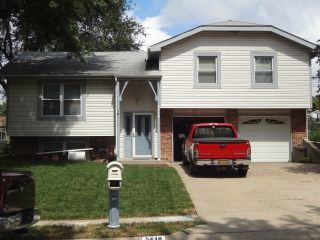
Sample Report
| Client(s): | John Doe |
| Property address: | XYZ Lane Kansas city, KS 66106 |
| Inspection date: | Tuesday, September 2, 2014 |
This report published on Tuesday, April 10, 2018 3:14:14 PM CDT
How to Read this Report
This report is organized by the property's functional areas. Within each functional area, descriptive information is listed first and is shown in bold type. Items of concern follow descriptive information.
Concerns are shown and sorted according to these types:| Safety | Poses a safety hazard | |
| Repair/Replace | Recommend repairing or replacing | |
| Repair/Maintain | Recommend repair and/or maintenance | |
| Maintain | Recommend ongoing maintenance | |
| Evaluate | Recommend evaluation by a specialist | |
| Monitor | Recommend monitoring in the future | |
| Serviceable | Item or component is in serviceable condition | |
| Comment | For your information |
Click here for a glossary of building construction terms.Contact your inspector If there are terms that you do not understand, or visit the glossary of construction terms at https://www.reporthost.com/glossary.asp
Table of Contents
General InformationGrounds
Exterior and Foundation
Basement
Roof
Attic and Roof Structure
Garage or Carport
Electric
Plumbing / Fuel Systems
Water Heater
Heating, Ventilation and Air Condition (HVAC)
Fireplaces, Stoves, Chimneys and Flues
Kitchen
Bathrooms, Laundry and Sinks
Interior, Doors and Windows
View summary
General Information
Report number: mockinspection4
Time started: 12:40
Present during inspection: Client, Property owner
Client present for discussion at end of inspection: Yes
Weather conditions during inspection: cloudy
Temperature during inspection: Warm
Type of building: Single family
Buildings inspected: One house
Number of residential units inspected: 1
Age of main building: 37
Source for main building age: Client, Property owner
Front of building faces: South
Main entrance faces: South
Occupied: Yes
Time finished: 2:45
Present during inspection: Property owner
Weather conditions during inspection: Dry (no rain)
Source for main building age: Property owner
1)
http://www.reporthost.com/?EPA
http://www.reporthost.com/?CPSC
http://www.reporthost.com/?CDC
Grounds
Limitations: Unless specifically included in the inspection, the following items and any related equipment, controls, electric systems and/or plumbing systems are excluded from this inspection: detached buildings or structures; fences and gates; retaining walls; underground drainage systems, catch basins or concealed sump pumps; swimming pools and related safety equipment, spas, hot tubs or saunas; whether deck, balcony and/or stair membranes are watertight; trees, landscaping, properties of soil, soil stability, erosion and erosion control; ponds, water features, irrigation or yard sprinkler systems; sport courts, playground, recreation or leisure equipment; areas below the exterior structures with less than 3 feet of vertical clearance; invisible fencing; sea walls, docks and boathouses; retractable awnings. Any comments made regarding these items are as a courtesy only.
Condition of driveway: Required repair, replacement and/or evaluation (see comments below)
Driveway material: Poured in place concrete
Condition of sidewalks and/or patios: Appeared serviceable
Condition of deck, patio and/or porch covers: Appeared serviceable
Condition of decks, porches and/or balconies: Appeared serviceable
Deck, porch and/or balcony material: Wood, Plastic fiber
Condition of stairs, handrails and guardrails: Appeared serviceable
2)
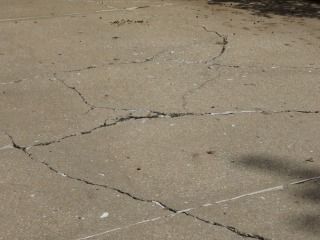 Photo 2-1 |
3)
Exterior and Foundation
Limitations: The inspector performs a visual inspection of accessible components or systems at the exterior. Items excluded from this inspection include below-grade foundation walls and footings; foundations, exterior surfaces or components obscured by vegetation, stored items or debris; wall structures obscured by coverings such as siding or trim. Some items such as siding, trim, soffits, vents and windows are often high off the ground, and may be viewed using binoculars from the ground or from a ladder. This may limit a full evaluation. Regarding foundations, some amount of cracking is normal in concrete slabs and foundation walls due to shrinkage and drying. Note that the inspector does not determine the adequacy of seismic reinforcement.
Wall inspection method: Viewed from ground
Condition of wall exterior covering: Appeared serviceable
Apparent wall structure: Wood frame
Wall covering: Vinyl, Brick veneer
Footing material (under foundation stem wall): concrete
foundation type: poured in place concrete
Basement
Limitations: Structural components such as joists and beams, and other components such as piping, wiring and/or ducting that are obscured by under-floor insulation are also excluded from this inspection. Note that the inspector does not determine if support posts, columns, beams, joists, studs, trusses, etc. are of adequate size, spanning or spacing.
The inspector does not guarantee or warrant that water will not accumulate in the basement in the future. Access to the basement during all seasons and during prolonged periods of all types of weather conditions (e.g. heavy rain, melting snow) would be needed to do so. The inspector does not determine the adequacy of basement floor or stairwell drains, or determine if such drains are clear or clogged.
Note that all basement areas should be checked periodically for water intrusion, plumbing leaks and pest activity.
The inspector does not guarantee or warrant that water will not accumulate in the basement in the future. Access to the basement during all seasons and during prolonged periods of all types of weather conditions (e.g. heavy rain, melting snow) would be needed to do so. The inspector does not determine the adequacy of basement floor or stairwell drains, or determine if such drains are clear or clogged.
Note that all basement areas should be checked periodically for water intrusion, plumbing leaks and pest activity.
Condition of exterior entry doors: Appeared serviceable
Exterior door material: Wood
Condition of floor substructure above: Appeared serviceable
Pier or support post material: steel
Floor structure above: Solid wood joists
Condition of insulation underneath floor above: Appeared serviceable
Insulation material underneath floor above: Fiberglass roll or batt
Roof
Limitations: The following items or areas are not included in this inspection: areas that could not be traversed or viewed clearly due to lack of access; solar roofing components. Any comments made regarding these items are made as a courtesy only. Note that the inspector does not provide an estimate of remaining life on the roof surface material, nor guarantee that leaks have not occurred in the roof surface, skylights or roof penetrations in the past. Regarding roof leaks, only active leaks, visible evidence of possible sources of leaks, and evidence of past leaks observed during the inspection are reported on as part of this inspection. The inspector does not guarantee or warrant that leaks will not occur in the future. Complete access to all roof and attic spaces during all seasons and during prolonged periods of all types of weather conditions (e.g. high wind and rain, melting snow) would be needed to do so. Regarding the roof drainage system, unless the inspection was conducted during and after prolonged periods of heavy rain, the inspector was unable to determine if gutters, downspouts and extensions performed adequately or were leak-free.
Roof inspection method: Traversed
Condition of roof surface material: Appeared serviceable
Roof surface material: Asphalt or fiberglass composition shingles
Roof type: Gable
Apparent number of layers of roof surface material: One
Condition of exposed flashings: Required repair, replacement and/or evaluation (see comments below)
Condition of gutters, downspouts and extensions: Appeared serviceable
4)
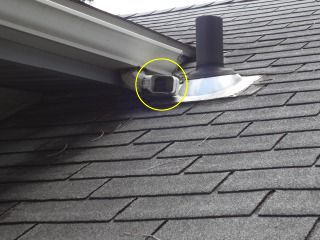 Photo 4-1 |
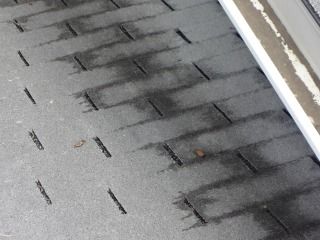 Photo 4-2 |
5)
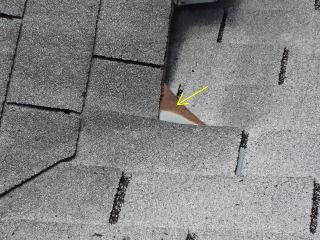 Photo 5-1 |
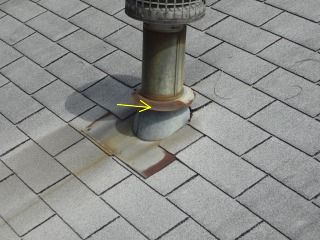 Photo 5-2 |
Attic and Roof Structure
Limitations: The following items or areas are not included in this inspection: areas that could not be traversed or viewed clearly due to lack of access; areas and components obscured by insulation. Any comments made regarding these items are made as a courtesy only. The inspector does not determine the adequacy of the attic ventilation system. Complete access to all roof and attic spaces during all seasons and during prolonged periods of all types of weather conditions (e.g. high/low temperatures, high/low humidity, high wind and rain, melting snow) would be needed to do so. The inspector is not a licensed engineer and does not determine the adequacy of roof structure components such as trusses, rafters or ceiling beams, or their spacing or sizing.
Attic inspection method: Traversed
Condition of roof structure: Appeared serviceable
Roof structure type: Rafters
Ceiling structure: Ceiling joists
Condition of insulation in attic (ceiling, skylight chase, etc.): Required repair, replacement and/or evaluation (see comments below)
Ceiling insulation material: Fiberglass loose fill, Cellulose roll or batt
Approximate attic insulation R value (may vary in areas): R-19
Roof ventilation type: Gable end vents, Mechanical vents with turbine
6)
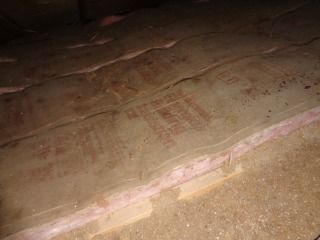 Photo 6-1 |
7)
http://www.reporthost.com/?ATTACC
Garage or Carport
Limitations: The inspector does not determine the adequacy of firewall ratings. Requirements for ventilation in garages vary between municipalities.
Type: Attached
Condition of door between garage and house: Appeared serviceable
Type of door between garage and house: Solid core
Condition of garage vehicle door(s): Appeared serviceable
Type of garage vehicle door: Sliding
Number of vehicle doors: 2
Condition of automatic opener(s): Required repair, replacement and/or evaluation (see comments below)
Mechanical auto-reverse operable (reverses when meeting reasonable resistance during closing): Yes
Condition of garage floor: Appeared serviceable
8)
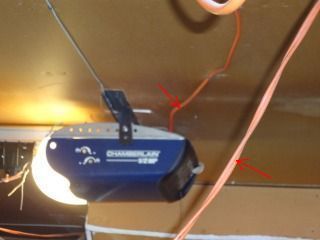 Photo 8-1 |
9)
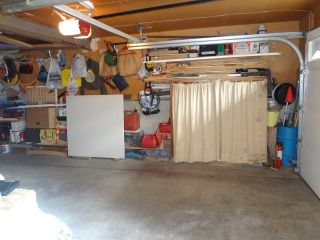 Photo 9-1 |
Electric
Limitations: The following items are not included in this inspection: generator systems, transfer switches, surge suppressors, inaccessible or concealed wiring; underground utilities and systems; low-voltage lighting or lighting on timers or sensors. Any comments made regarding these items are as a courtesy only. Note that the inspector does not determine the adequacy of grounding or bonding, if this system has an adequate capacity for the client's specific or anticipated needs, or if this system has any reserve capacity for additions or expansion. The inspector does not operate circuit breakers as part of the inspection, and does not install or change light bulbs. The inspector does not evaluate every wall switch or receptacle, but instead tests a representative number of them per various standards of practice. When furnishings, stored items or child-protective caps are present some receptacles are usually inaccessible and are not tested; these are excluded from this inspection. Receptacles that are not of standard 110 volt configuration, including 240-volt dryer receptacles, are not tested and are excluded. The functionality of, power source for and placement of smoke and carbon monoxide alarms is not determined as part of this inspection. Upon taking occupancy, proper operating and placement of smoke and carbon monoxide alarms should be verified and batteries should be changed. These devices have a limited lifespan and should be replaced every 10 years. The inspector attempts to locate and evaluate all main and sub-panels. However, panels are often concealed. If panels are found after the inspection, a qualified electrician should evaluate and repair if necessary. The inspector attempts to determine the overall electrical service size, but such estimates are not guaranteed because the overall capacity may be diminished by lesser-rated components in the system. Any repairs recommended should be made by a licensed electrician.
Electric service condition: Appeared serviceable
Primary service type: Overhead
Number of service conductors: 2
Service voltage (volts): 120-240
Estimated service amperage: 125
Primary service overload protection type: Circuit breakers
Service entrance conductor material: Not determined (components inaccessible or obscured)
Main disconnect rating (amps): 200
Condition of main service panel: Required repair, replacement and/or evaluation (see comments below)sylvania
Location of main service panel #A: Basement
Branch circuit wiring type: Non-metallic sheathed
Electric service condition: Required repair, replacement and/or evaluation (see comments below)
Service entrance conductor material: Stranded copper
System ground: Ground rod(s) in soil
Condition of main service panel: Required repair, replacement and/or evaluation (see comments below)
Condition of branch circuit wiring: Serviceable
Branch circuit wiring type: Copper
Ground fault circuit interrupter (GFCI) protection present: Yesin bathrooms and kitchen
Arc fault circuit interrupter (AFCI) protection present: Not determinedpanel not opened
10)
http://www.reporthost.com/?ZINSCO1
http://www.reporthost.com/?ZINSCO2
Sylvania is another name for a zinsco
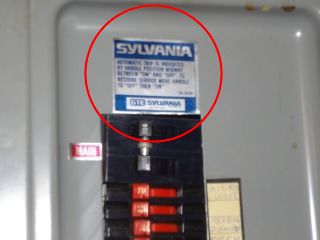 Photo 10-1 |
11)
12)
Plumbing / Fuel Systems
Limitations: The following items are not included in this inspection: private/shared wells and related equipment; private sewage disposal systems; hot tubs or spas; main, side and lateral sewer lines; gray water systems; pressure boosting systems; trap primers; incinerating or composting toilets; fire suppression systems; water softeners, conditioners or filtering systems; plumbing components concealed within the foundation or building structure, or in inaccessible areas such as below tubs; underground utilities and systems; overflow drains for tubs and sinks; backflow prevention devices. Any comments made regarding these items are as a courtesy only. Note that the inspector does not operate water supply or shut-off valves due to the possibility of valves leaking or breaking when operated. The inspector does not test for lead in the water supply, the water pipes or solder, does not determine if plumbing and fuel lines are adequately sized, and does not determine the existence or condition of underground or above-ground fuel tanks.
Condition of service and main line: Appeared serviceable
Water service: Public
Location of main water shut-off: Basement
Condition of supply lines: Appeared serviceable
Supply pipe material: Copper, PEX plastic
13)
Water Heater
Limitations: Evaluation of and determining the adequacy or completeness of the following items are not included in this inspection: water recirculation pumps; solar water heating systems; Energy Smart or energy saver controls; catch pan drains. Any comments made regarding these items are as a courtesy only. Note that the inspector does not provide an estimate of remaining life on water heaters, does not determine if water heaters are appropriately sized, or perform any evaluations that require a pilot light to be lit or a shut-off valve to be operated.
Condition of water heater: Appeared serviceable, Near, at or beyond service life
Type: Tank
Energy source: Electricity, Natural gas
Estimated age: 12 years
Capacity (in gallons): 40
Temperature-pressure relief valve installed: Yes
Location of water heater: Basement
Hot water temperature tested: Yes
14)
Heating, Ventilation and Air Condition (HVAC)
General heating system type(s): Forced air
General heating distribution type(s): Ducts and registers
Last service date of primary heat source: 2013
Source for last service date of primary heat source: Property owner
Condition of forced air heating/(cooling) system: Appeared serviceable
Forced air heating system fuel type: Natural gas
Location of forced air furnace: Basement
Forced air system capacity in BTUs or kilowatts: 66000
Condition of furnace filters: Appeared serviceable
Condition of forced air ducts and registers: Appeared serviceable
Condition of burners: Appeared serviceable
Condition of cooling system and/or heat pump: Appeared serviceable
Cooling system and/or heat pump fuel type: Electric
Location: outside
Condition of controls: Appeared serviceable
Limitations: The following items are not included in this inspection: humidifiers, dehumidifiers, electronic air filters; solar, coal or wood-fired heat systems; thermostat or temperature control accuracy and timed functions; heating components concealed within the building structure or in inaccessible areas; underground utilities and systems; safety devices and controls (due to automatic operation). Any comments made regarding these items are as a courtesy only. Note that the inspector does not provide an estimate of remaining life on heating or cooling system components, does not determine if heating or cooling systems are appropriately sized, does not test coolant pressure, or perform any evaluations that require a pilot light to be lit, a shut-off valve to be operated, a circuit breaker to be turned "on" or a serviceman's or oil emergency switch to be operated. It is beyond the scope of this inspection to determine if furnace heat exchangers are intact and free of leaks. Condensation pans and drain lines may clog or leak at any time and should be monitored while in operation in the future. Where buildings contain furnishings or stored items, the inspector may not be able to verify that a heat source is present in all "liveable" rooms (e.g. bedrooms, kitchens and living/dining rooms).
Estimated age of forced air furnace: 12
Location for forced air filter(s): At end of air handler
Type of combustion air supply: Intake duct
Condition of venting system: Appeared serviceable
Fireplaces, Stoves, Chimneys and Flues
Limitations: The following items are not included in this inspection: coal stoves, gas logs, chimney flues (except where visible). Any comments made regarding these items are as a courtesy only. Note that the inspector does not determine the adequacy of drafting or sizing in fireplace and stove flues, and also does not determine if prefabricated or zero-clearance fireplaces are installed in accordance with the manufacturer's specifications. The inspector does not perform any evaluations that require a pilot light to be lit, and does not light fires. The inspector provides a basic visual examination of a chimney and any associated wood burning device. The National Fire Protection Association has stated that an in-depth Level 2 chimney inspection should be part of every sale or transfer of property with a wood-burning device. Such an inspection may reveal defects that are not apparent to the home inspector who is a generalist.
Fireplace type: masonary
Chimney type: metal with wood enclosure
Gas flue type: b vent
chimney and flue condition: appeared serviceable
Kitchen
Limitations: The following items are not included in this inspection: household appliances such as stoves, ovens, cook tops, ranges, warming ovens, griddles, broilers, dishwashers, trash compactors, refrigerators, freezers, ice makers, hot water dispensers and water filters; appliance timers, clocks, cook functions, self and/or continuous cleaning operations, thermostat or temperature control accuracy, and lights. Any comments made regarding these items are as a courtesy only. Note that the inspector does not provide an estimate of the remaining life of appliances, and does not determine the adequacy of operation of appliances. The inspector does not note appliance manufacturers, models or serial numbers and does not determine if appliances are subject to recalls. Areas and components behind and obscured by appliances are inaccessible and excluded from this inspection.
Condition of counters: Appeared serviceable
Condition of cabinets: Appeared serviceable
Condition of sinks and related plumbing: Appeared serviceable
Condition of under-sink food disposal: Appeared serviceable
Condition of dishwasher: Appeared serviceable
Condition of range, cooktop or oven: Appeared serviceable
Range, cooktop or oven type: Electric
Type of ventilation: Hood or built into microwave over range or cooktop
Condition of refrigerator: Appeared serviceable
Bathrooms, Laundry and Sinks
Limitations: The following items are not included in this inspection: overflow drains for tubs and sinks; heated towel racks, saunas, steam generators, clothes washers, clothes dryers. Any comments made regarding these items are as a courtesy only. Note that the inspector does not determine the adequacy of washing machine drain lines, washing machine catch pan drain lines, or clothes dryer exhaust ducts. The inspector does not operate water supply or shut-off valves for sinks, toilets, bidets, clothes washers, etc. due to the possibility of valves leaking or breaking when operated. The inspector does not determine if shower pans or tub and shower enclosures are water tight, or determine the completeness or operability of any gas piping to laundry appliances.
Location #A: Full bath
Location #B: 3/4 bath
Condition of cabinets: Appeared serviceable
Condition of flooring: Appeared serviceable
Condition of sinks and related plumbing: Appeared serviceable
Condition of toilets: Appeared serviceable
Condition of bathtubs and related plumbing: Appeared serviceable
Condition of ventilation systems: Appeared serviceable
Bathroom and laundry ventilation type: Spot exhaust fans
Gas supply for laundry equipment present: No
Interior, Doors and Windows
Limitations: The following items are not included in this inspection: security, intercom and sound systems; communications wiring; central vacuum systems; elevators and stair lifts; cosmetic deficiencies such as nail-pops, scuff marks, dents, dings, blemishes or issues due to normal wear and tear in wall, floor and ceiling surfaces and coverings, or in equipment; deficiencies relating to interior decorating; low voltage and gas lighting systems. Any comments made regarding these items are as a courtesy only. Note that the inspector does not evaluate any areas or items which require moving stored items, furnishings, debris, equipment, floor coverings, insulation or similar materials. The inspector does not test for asbestos, lead, radon, mold, hazardous waste, urea formaldehyde urethane, or any other toxic substance. Some items such as window, drawer, cabinet door or closet door operability are tested on a sampled basis. The client should be aware that paint may obscure wall and ceiling defects, floor coverings may obscure floor defects, and furnishings may obscure wall, floor and floor covering defects. If furnishings were present during the inspection, recommend a full evaluation of walls, floors and ceilings that were previously obscured when possible. Determining the cause and/or source of odors is not within the scope of this inspection.
Condition of exterior entry doors: Appeared serviceable
Exterior door material: Wood
Condition of interior doors: Appeared serviceable
Condition of windows and skylights: Appeared serviceable
Type(s) of windows: Vinyl
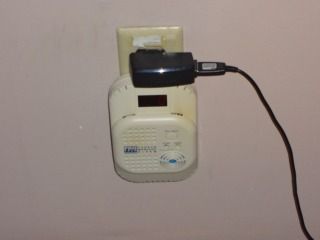 Photo X-1 Plug in Carbon Monoxide monitors are not recommended because they wont work if the electricity is shut off. Recommend installing battery operated monitors.
|
Thank you for choosing Crest Home Inspections. Your safety is our primary concern.
